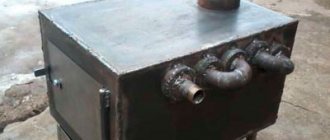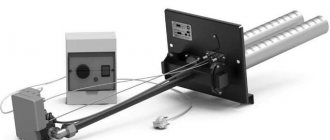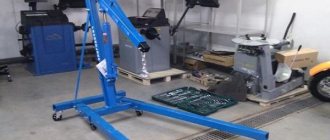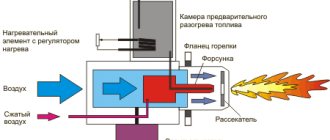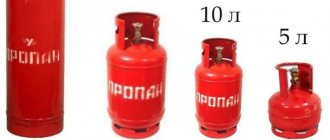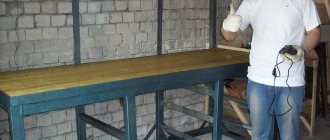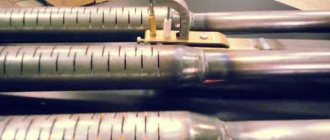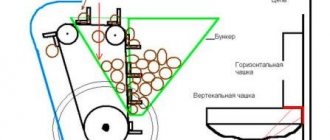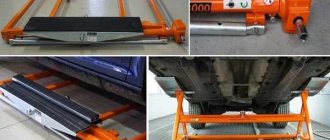Design of heating equipment running on diesel fuel
A factory or homemade diesel garage heater is multifunctional equipment.
It can be used as the main, additional or alternative source of thermal energy if there is a heating system already installed in the room. If necessary, the stove can be used as a hob: food can be quickly heated on it and the kettle can boil.
Important! Diesel heaters are strictly prohibited from being installed in poorly ventilated areas. And if during operation the stove almost does not emit harmful substances into the atmosphere, then during ignition and extinguishing the fire, emissions of a small amount of compounds hazardous to human health are observed in the smoke
Many models of diesel stoves can operate not only on DP, but also on other types of liquid fuel. Judging by reviews from consumers and some experts, the best option in this case is kerosene. But due to a huge desire to save money, people prefer diesel fuel.
For reference! Diesel stoves are very economical: based on practice, one tank refill is enough for continuous operation of the heater for 6-28 hours. Take-off time is regulated by the design of the model and the volume of the fuel tank.
The operating principle of a heat gun.
Heaters of this type consist of a fuel tank - in most cases it is removable, equipped with a valve, a replaceable block with a wick, an adjusting screw, a reflector and the burner itself. All structural elements are located in a common housing.
If we are talking about homemade equipment, then a barrel, a tank welded from sheets of heat-resistant steel, or even a used gas cylinder will work as a body.
The burner is placed in the center of the structure. Fuel is supplied to it from a tank located at the rear wall of the device body. In order to achieve the required temperature, an adjustment screw is used. And due to the reflector included in the design, quick and reliable heating of the room is ensured.
If you plan to purchase a factory heater, then it is better to give preference to compact models weighing 10-20 kg. Such equipment, if necessary, can be easily moved to another location using your own resources.
Compact liquid fuel stove
Both factory-made and home-made models of stoves using diesel fuel, kerosene or oil are distinguished by their compactness and mobility. At the same time, they maintain excellent heat transfer performance. Although such units are small in size, they do an excellent job within the technical specifications.
The stove can be used to heat country houses, greenhouses, garages, sheds and other small areas. Moreover, due to the compactness of the units, they are often taken with them on hikes or fishing.
Fuel consumption, even depending on the model, type of fuel and power characteristics, is low. For example, popular medium-power stoves of 2.5 kW consume no more than 200 ml of diesel fuel per hour of operation. When using oil or kerosene, there will be no significant difference in consumption.
Ordinary kerogas has much in common with the design of modern miracle diesel stoves. They use the same operating principle. Thanks to the simple and understandable design of the unit, you can do it yourself.
Device and principle of operation
If the device of a factory model may not be of interest to everyone, then home-made options are of particular interest.
In any case, it will be useful to know the structure and operating principle of a diesel fuel stove.
The structure consists of:
- removable fuel tank;
- main working unit with wick;
- adjusting screw;
- reflector;
- burners;
- depending on the design, there may be a grate for cooking food or heating water, which can be removed if necessary.
The general operating principle is simple. From the tank, flammable liquid flows by gravity into the bowl with the wick. When the tank is first filled, you need to wait 10-15 minutes until the wick is well saturated, after which you begin to ignite.
A diesel fuel stove has a very simple operating principle.
In turn, the reflector dissipates the heat received from the flame well and evenly. It itself is coated with powder paint so that it retains its original properties under the influence of temperature. The intensity of the flame, and therefore the heat emitted, is adjusted using a special screw. It also helps to turn off the oven completely.
The entire structure is made of fireproof steel, which increases the service life of the unit. The wick is a consumable item, so it is preferable to have several copies in reserve so as not to find yourself without heat at the most inopportune moment.
Ignition process
The principle of operation of a diesel fuel stove with your own hands is clear, but when lighting such a device for the first time, you need to know the procedure and some nuances.
It is convenient to take a diesel stove with you on a hike or on a picnic
First the wick is placed. To do this, you need to remove the grille and wrap it around a cylindrical base in the block. Then put everything back in place and install the grille.
The tank is filled with fuel and the valve is opened so that the wick is saturated faster. After which it can be covered and lit. Adjust the flame with a screw specially designed for this purpose. For the diesel fuel stove to enter operating mode, you need to wait a little and let it warm up. After this, it is necessary to adjust the required flame level and heat transfer intensity.
You can turn off the stove by closing the control valve. Experts recommend lighting and extinguishing the heater outside, this will get rid of the unpleasant smell in the room. It is also recommended to use kerosene as fuel, which during the combustion process eliminates the formation of an unpleasant odor and significantly increases the efficiency of the stove.
In this video, learn more about the miracle stove Solarogas:
Advantages and disadvantages
Despite the obvious advantages, diesel stoves also have disadvantages that should be taken into account when choosing such devices as a heater.
The main advantages of liquid fuel heaters include:
- autonomy, that is, such a unit does not require connection to a power source;
- uniform heating of the room;
- control over the combustion process;
- low cost of both factory and home-made models;
- possibility of cooking or heating food;
- low emission of soot and smoke, and in some models even their absence;
- can work without human intervention;
- efficiency;
- mobility due to low weight and dimensions;
- high fire safety.
The disadvantages of the stove are:
- does not accept unrefined or frozen (too cold) oil;
- cannot be used in rooms without ventilation;
- low inertia;
- the occurrence of unpleasant odors.
Disadvantages, unfortunately, are not only present, but in certain situations they are extremely important and undesirable. If you can put up with using oil, the appearance of an unpleasant odor in the room will definitely alert you, especially in the absence of ventilation.
When the heated room is well ventilated, there is access to air or high-quality removal of combustion products, then the negative aspects of the operation of the device become less significant
Safety of use
A well-made homemade diesel stove for a garage is relatively safe. However, sometimes things can go wrong, so handling fire involves following some rules and regulations.
This miracle stove will come in handy in a garage or shed
To avoid unpleasant consequences, you should always remember:
- heaters (of any design) cannot be installed near flammable objects and materials;
- You cannot place objects weighing more than 5 kg on the device;
- the place where the device will be located during operation must be provided with a fire-resistant coating; a sheet of non-combustible material can be placed;
- It is not recommended to use the stove in rooms where there is no ventilation;
- It is necessary to use only prescribed liquids as fuel: diesel fuel, kerosene, oil or others permitted for a specific model;
- you should constantly monitor the tightness of parts;
- During operation, you need to ensure that water does not get into the fuel.
Subject to compliance with safety regulations, any heater model will be a convenient, comfortable and safe means of heating.
Pyrolysis oven
A pyrolysis stove is a heating device that consists of two consecutive combustion chambers. In the first section, fuel (wood, coal, etc.) smolders, releasing pyrolysis gas, which, under the influence of forced or natural draft, enters the second chamber, where it mixes with oxygen. The efficiency of this heating device is 90-95%. Pellets, dry firewood, branches, sawdust and other wood residues are used as fuel.
Scheme of operation of a pyrolysis furnace
A pyrolysis stove heats the room by heating the walls of the stove. To increase heat transfer, craftsmen lay fireclay bricks inside the furnace and refractory bricks outside. Technology for creating a pyrolysis stove with your own hands:
- Using welding, a stove body with openings for the firebox and ash pan is formed from a sheet of steel. A grate (grid made of reinforcement) is installed between the combustion chamber and the place for the ash.
- The combustion chamber is located above the firebox; they are separated from each other by a steel plate.
- In the upper section there is a damper for air supply.
- The body is covered with bricks.
- A heat-insulated chimney pipe is installed on top of the stove.
If desired, a pyrolysis potbelly stove can be coated with heat-resistant paint. Such a heating device will fit perfectly into the interior of a country house, garage or utility room.
Blitz tips
To summarize, here are the latest recommendations for the use of such stoves:
- The intensity of the odor depends on the power of the stove, the quality of the fuel and the duration of operation. It is for this reason that they are rarely used for heating residential premises.
- You can use not only diesel fuel as fuel, but also used engine oil. Its low cost allows you to significantly save money.
- It is recommended to clean the stove from accumulated combustion products every 1-2 weeks; such care can significantly increase its service life.
Manufacturing instructions
There are many instructions on the Internet that describe the manufacturing procedure in detail. But such a stove comes in a variety of types, each of them has its own advantages and disadvantages, so an ignorant person often finds it difficult to choose the appropriate option
Also, when choosing a particular model, you need to take into account the conditions of future operation.
Drip furnace
Drip furnace
The most optimal option for use at home. Manufacturing does not require much time, and the finished structure will take only a few square meters of space (if we talk about the largest option). But in most cases it is made portable, which is why it is very popular among tourists for heating tents.
The manufacturing technology of the drip structure is as follows.
First stage. First, take a medical burner (its capacity usually does not exceed two liters).
Second phase. The burner is equipped with a rubber hose with a copper tube of the appropriate diameter connected to it, after which the tube is bent at an angle of 90°C.
Third stage. Then the hose should be bent in half.
Fourth stage. Take a clamp equipped with a screw and attach it to the bend.
If a larger drip furnace is needed, then sheet metal must be used for manufacturing. In this case, the structure will consist of a pair of parts that fit into each other and will be located away from the front door. It must be remembered that the operating principle of such structures is based on the periodic supply of diesel fuel to the fuel tank. This allows the construction of furnaces of various sizes and shapes.
Two-tank stove
Two-tank stove
There is another equally popular manufacturing method, based on the use of several tanks connected to each other by perforated (that is, with numerous holes) pipes. In this case, the lower reservoir serves not only as a fuel tank, but also as a combustion chamber. The capacity of this design is impressive - about 12 liters. For the manufacture of the case, steel sheets with a thickness of 3 mm to 5 mm are used, which prevents the walls from burning through and, therefore, increases the service life of the device.
Two-tank stove
A hole is made in the upper tank with a closing lid. A pipe is welded to the bottom of the housing, onto which the exhaust pipe is installed. To make this pipe, it is necessary to use only galvanized steel, since the temperature of this element during operation can reach 250ᵒC. If the room in which the stove is installed has a small area, then it is advisable to make the upper part of the structure removable for more convenient cleaning.
What should the heating be like in a garage?
For many motorists, the garage is almost a second home. Here they delve into their hobby, take a break from the hustle and bustle and take care of the car. Therefore, first of all, you should think about the comfort of the person who spends hours indoors.
Heating is also necessary for the car, because... low temperatures negatively affect its technical condition and significantly reduce its service life.
When it gets cold, the garage becomes too humid. Condensation forms on metal parts, which provokes corrosion processes. In a cold room, the car body quickly rusts and becomes unusable.
To keep the garage dry, you should take care of good waterproofing and ensure the normal operation of the ventilation system. However, moisture still gets into the room on the wheels of the car. It evaporates and drops of water settle on surfaces. If there is no heating, moisture accumulates, causing fungus, mold, and rust to appear. To prevent this from happening, heating is necessary.
Low temperatures cause the oil to thicken and reduce battery capacity. This makes it difficult to start the engine and increases fuel consumption. Therefore, it makes sense to spend time and effort assembling a miracle stove
Features of garage operation determine the requirements for heating systems:
- Efficiency. The oven must heat the air quickly and maintain the desired temperature for several hours.
- Easy to use. When coming to the garage, its owner should spend a minimum of time and effort heating the room.
- Ease of maintenance. The stove must be inspected, cleaned, and repaired in a timely manner, so its design must be simple and understandable, and its parts must be easily replaceable.
- Availability of energy source. When choosing a heating system, fuel availability is of fundamental importance. A stove using diesel fuel, diesel fuel or waste oil is well suited for a garage.
- Safety. There is always some amount of flammable substances in the garage. Since these premises often serve as workshops and sheds, flammable materials will often be found here. Therefore, heating must comply with all fire safety standards.
- Cheapness. The costs of servicing a car and arranging a garage are already high, so saving on heating without compromising its quality is a pressing issue.
When choosing a suitable heating device, you should set priorities, because... the ideal is unattainable. The easiest to use are electric heaters. This energy source is available in almost any location. However, the price of heating with electricity is too high, so it is worth considering other options.
Image gallery Photos from This heating method is chosen by people who are willing to spend money on an infrared heater and pay electricity bills. Although the devices are very economical, they are still not cheap. The main advantage of infrared heating: objects are heated, not air (it warms up indirectly by coming into contact with warm surfaces). This allows you to create local thermal zones
Garage owners who have the opportunity to buy solid fuel inexpensively make good old potbelly stoves. Such heating is reliable, and its effectiveness has been proven over time. There are also disadvantages: you will have to install a chimney, and keep a supply of fuel in the garage, which takes up a lot of space
Heat guns are often purchased to heat garages, workshops, and utility rooms. There are many models powered by gas cylinders, electricity or diesel fuel. Every garage owner will definitely find a suitable option. The only negative is the high price of the device
Industrially produced models are compact, beautiful, easy to use, but not cheap. If you make a miracle stove yourself, you will get a completely functional and inexpensive design. The only negative: from a design point of view, it will not be able to compete with aesthetic industrial models
Heating with infrared heater
Homemade potbelly stove using solid fuel
Gas heat gun in the garage
Miracle diesel stove
Review of diesel heating boilers
An example of installing a boiler on diesel fuel.
For more efficient operation of heating on diesel fuel, you can purchase a special boiler. Such models are distinguished by increased efficiency indicators, since their design, and in particular the heat exchanger, is designed to operate on liquid fuel.
Installing a burner in a conventional solid fuel boiler will not always create the desired level of heating of the coolant. Therefore, it is recommended to purchase factory models.
Kiturami boilers
One of the most popular manufacturers of heating boilers running on diesel fuel. This South Korean company specializes in the production of heating equipment. The most popular models currently are:
- TURBO-17 is a double-circuit boiler with a rated power of 19.8 kW. The DHW capacity for it is 7.1 l/min. Cost – 39 thousand rubles;
- TURBO-30U. The most powerful model in the product line. Its operation makes it possible to provide heat to a house of up to 250 m². Cost – 57 thousand rubles.
All these models are floor-mounted, characterized by simple installation, as well as the ability to install a coaxial chimney.
Fondital boilers
The undeniable quality of the Italian brand is confirmed by customer demand. The company focused on optimal configuration, which had a positive effect on functionality:
- Capri BTF 33. Net power – 33 kW. The heat exchanger and housing are made of cast iron, which has a positive effect on service life. The advantage is the built-in 130 l expansion tank. Cost – 74 thousand rubles;
- CAPRI BTF 23. Completely similar to the above except for power. It is 23 kW.
Another advantage of buying factory models is the opportunity to get information from the manufacturer on how to properly heat a private house with diesel fuel with your own hands: boilers, consumption, diagrams and other useful data.
Other stove options for non-residential premises
Waste oil burners
Attract those who have access to this type of fuel
Although it is not so easy to make a burner, it must be used with great care, but it gives its efficiency and does not lose popularity in its circles
Long burning stoves
They run on good quality solid fuel.
Special convection pipes on their sides draw in and warm the air, accelerating its circulation in the room.
Well-known models of this type: Buleryans, Brenerans, Butakovs, Termofor, Teplodar, Burzhuy-k, Besser.
So, whether a stove is good in comparison with other options can only be judged if you select two units for the same purpose.
For example, electric heaters can produce a third more power for the same cost, and some boilers can run on waste wood, which is much cheaper.
However, kerogen gas (and modern solar gases are those same kerogen gases) was not developed with the goal of reducing costs to a minimum, but as a portable and compact travel option. And I must say, it turned out to be a really convenient and safe stove.
Where are they used?
Regardless of what type of fuel is used in heaters, all devices have one important advantage. They are able to work for quite a long time, without human participation and control.
As you already understand, heaters running on diesel fuel will be an excellent help in a greenhouse or garage. With their help, you can effectively heat a warehouse or industrial space. Portable, non-volatile models are convenient to take with you to the forest or fishing. With their help, you can not only heat your tent, but also quickly prepare hot food.
Infrared diesel heaters are successfully used on open verandas and work sites. And of course, with the help of such devices you can effectively heat a dacha or a small country house.
Advantages of a diesel stove
Inside diesel heating stoves, it is not liquid fuel that burns, but its vapor mixed with air or rags soaked in diesel fuel. Liquid fuel is poured inside the tank, which begins to evaporate. During the ignition process, a temperature is created sufficient for the vapors to ignite and begin to burn.
Here are a few advantages of equipment of this design:
- It practically does not emit harmful combustion products - they are formed only during the ignition process. The diesel stove does not smoke or produce soot.
- This design is considered completely safe and therefore does not require constant supervision.
- Since diesel fuel has a high density, it is consumed very economically.
- It is allowed to combine diesel fuel with various biofuels, in particular with vegetable oil.
- The ovens are small in size and can be easily moved to another location.
Sometimes homemade diesel stoves are equipped with a flat container in the upper part, which serves as a heat exchanger and can be used for cooking or heating water.
Diesel Sheet Metal Heater
Externally, diesel stoves for metal garages look like two disks joined together by a tube with many holes and an outlet pipe for combustion products on top. The device is assembled from two containers, which are connected to each other by a wick bowl, that is, a wide pipe with holes for air supply and smoke removal.
Diesel fuel enters the wick container from the fuel tank by gravity. In it, diesel fuel is heated and converted into a mixture of gas and air. It enters the combustion chamber, where it ignites. A spiral placed in the upper part of the combustion chamber acts as a heat exchanger. It can heat up to 800 ℃. The waste is discharged through a chimney.
This design is safe, economical and does not harm the environment. Assembly requires 2 sheets of 5 mm metal. The chimney is placed far from the door; it has two elbows nested inside each other. The container located below is the firebox and fuel tank. Fuel is poured into it through a hole. Capacity volume – from 2 to 12 liters.
Which diesel stove to choose
When choosing a stove for a garage that is powered by diesel fuel, you should take into account a number of characteristics, such as the power of the stove, the material of manufacture, the possibility of use at different times of the year, the price factor, etc.
Criteria
Power
An important parameter, because the more powerful the stove, the larger the area of the room it can quickly and efficiently heat. On average, for heating 10 square meters. meters of room you need to spend 1 kW of energy.
Based on these data, and knowing the area of your garage, you can calculate what power stove you need to purchase or manufacture.
Material of manufacture
Such devices are made mainly of steel - metal sheets and corners using welded joints. There are also homemade drip-type stoves, which are made from pipes or old gas cylinders.
The lower hemisphere of such a cylinder is used as a bowl where combustion occurs, and the fuel tank is placed outside the body; diesel fuel is dosed to the source of the flame through a metal tube, which eliminates spontaneous combustion.
Price factor
Prices for diesel stoves for garages are quite low, as well as for diesel fuel or fuel oil, and every car enthusiast has used oil on hand. From an economic point of view, such a heating device would be the best option.
Prices for stoves using diesel fuel start from 3,000 rubles. Diesel furnaces that run on fuel oil or waste oil are slightly more expensive.
Other points
- An important point is that the stove has an inspection window (plug). This allows you to control the combustion process and increase or decrease the supply of air mixture to the compartment where fuel combustion occurs.
- According to their dimensions and installation method, diesel stoves can be either large stationary or small portable. The choice here is huge and everyone can choose a unit based on their specific needs, goals and objectives.
- Multeat Eco 18. The model runs on used engine oil. Its cost is 21,500 rubles. The stove does not include a fuel tank; any tank with a tap and a fuel filter can be used as one. There is a system for controlling the supply of fuel to the combustion plate.
- Solar gas PO-2.5 Compact and inexpensive stove running on diesel fuel. It will cost the buyer only 3,300 rubles and is capable of heating a room of up to 25 square meters. meters, its power is 2.5 kW. It is very popular among hikers, summer residents and owners of small garages.
- Ritsa. A budget option for an oil-fired furnace. With the ability to heat an area of up to 150 sq. meters, its price will be only 7,000 rubles. There is a chimney and a 10 liter fuel tank.
- Polarus. A powerful heating unit for large rooms, the fuel used is waste machine oil. This 60 kW furnace is capable of heating 3000 cubic meters of air per hour. Price – 65,000 rubles.
- Multeat MUL. Another solid device for large areas in the form of a convection oven, running on old machine oil. Its cost is 56,500 rubles. Multeat MUL is capable of working both on waste fuel and on a mixture of diesel fuel and oil. Recommended for rooms up to 800 cubic meters.
Making a diesel stove with your own hands
Most of the diesel stoves in garages of car enthusiasts are not purchased, but homemade. Below is an example of a drawing of two drip-type stoves operating on diesel fuel; the first version is made from a gas cylinder and is intended for heating liquid in a closed circuit, and the second, made from a piece of pipe, is for air heating of the room.
Drawings of a diesel stove for a garage
Description of structural elements
What will be needed for production?
The main materials will be steel sheets, angles, pipes for the air duct, fasteners (bolts), a cylinder or a piece of pipe - it all depends on the imagination and capabilities of the designer. The tools you will need are:
- Welding machine.
- Bulgarian.
- Spanners.
- Measuring and marking tool.
Main stages of manufacturing
- The first step is to make four legs from the corners, their length is 25 - 30 cm.
- By welding, attach them to the lower compartment of the future structure.
- Make two holes for pipes in the lower and upper parts of the stove; the diameter of the lower one should be smaller than that of the upper outlet.
- Weld the lower pipeline, as well as a small piece of the upper pipe under the air duct. It should be removable and make it possible to conveniently clean the furnace boiler.
- Install the lower and upper parts of the stove, as well as the pipe for the burner. The flame will burn in the lower compartment, fuel will be supplied through the tube, and the upper part will act as a radiator.
- 10 - 12 holes need to be made in the fuel pipe at a distance of 5 cm between them, the first and last holes should be located no closer than 10 cm from the body of the diesel stove.
- Make a round window with a diameter of 15 cm in the fuel compartment and attach a plug to it using bolts. With its help, during the combustion of hydrocarbons, you can regulate the oxygen supply and draft.
- Install the chimney on the top of the stove and take it outside the room.
Design example
Another implementation option
In the video you can see various implementations of diesel fuel stoves:
Manufacturing
There are several options for making a diesel stove with your own hands. The simplest of them is a portable drip stove. It is made quite quickly and takes up little space. It can be moved from place to place, making this stove option one of the most popular. A portable stove is often used by tourists on hikes.
For a drip furnace you will need:
Medical heating pad, 2 liter capacity. Sold in any pharmacy.
Clamp with screw, small size.
- Metal container (barrel, cylinder).
- Copper pipe.
- Chimney pipe.
- Welding machine.
- Bulgarian.
Work on the manufacture of the furnace is carried out in the following order:
- A copper tube of suitable diameter, about 1.5 meters long, is connected to a rubber hose (usually about 2 meters long) from the heating pad. The tube is bent 90 degrees. The rubber hose needs to be bent in half and a small clamp with a screw should be installed in place of the bend. The heating pad acts as a fuel tank. Fuel from the heater goes through a rubber hose and then through a copper tube into the firebox. The fuel supply is regulated using a screw on the clamp. The diesel fuel should drip (hence the name - drip stove). The heating pad is hung on the wall away from the stove to prevent ignition.
- For the furnace body, use some kind of metal container, barrel or old cylinder. A small opening for the door is cut out on the side. There is no need for a vent in the oven, since a homemade oven is not a sealed structure.
- A chimney pipe is welded into the body. The length of the pipe is at least 4 meters. If the chimney is placed on the side, then the upper surface can be used as a hob.
- A hole is made in the furnace body for a copper tube through which fuel will flow into the firebox. Place it closer to the door, further from the chimney.
- Rags, pre-twisted with wire in the form of a briquette and impregnated with diesel fuel, are placed in the firebox on a refractory brick. Another option is to install a bowl filled with diesel fuel in the firebox. The outlet of the copper tube inside the furnace should be above the bowl.
Another common type of homemade diesel stove is a stove consisting of two containers connected by a perforated pipe. Fuel is poured into the lower container. A heating coil is placed above it. The coil heats up the diesel fuel and turns into a gaseous state. Vapors enter the upper chamber and burn in it.
To make such a stove, you need two metal tanks, metal for welding the lids, dampers, an angle grinder, a welding machine, corners that are welded and serve as the legs of the stove, and a pipe for the chimney.
Technology for constructing a diesel fuel furnace: existing options
Scheme of operation of a waste oil furnace.
The design, which was assembled by hand, is capable of saving more fuel than a device that can be bought in stores. It is possible to create a design that will be suitable for existing operating conditions.
Today there are quite a large number of instructions for the manufacture of devices of this type. These manuals describe in detail the process of assembling a diesel stove. It is quite difficult to choose a worthy option from them, because each of the designs has its own advantages and disadvantages, and is also focused on use in certain operating conditions.
A popular stove is made from a gas cylinder. A drawing of the stove can be seen in Fig. 3. If you comply with all existing norms and rules, the design will fully satisfy all fire safety requirements. If necessary, the device can be equipped with a water heating system. In severe frosts, the device will be able to maintain a comfortable temperature in the house.
A good option for small rooms is a drip stove. It can be made quite quickly and simply. The device is most often used to heat a tent for tourists. In order to make it yourself, you need:
- Take a medical burner with a capacity of about 2 liters.
- Next, you will need to connect a small copper tube that bends at a right angle to the rubber hose that is in the burner.
- The rubber hose should be bent in half.
- A clamp is installed at the bend, which is equipped with a screw. This must be done in order to regulate the fuel supply to the burner.
Pipe installation diagram.
In order to make large drip stoves, sheet metal should be used. In this case, the pipe will be located far from the door. The pipe consists of two elbows that fit into each other. It should be understood that the main principle of operation of such a stove is the gradual supply of kerosene to the fuel compartment. This makes it possible to build stoves of various designs.
Another manufacturing option is to assemble a stove from several containers, which are connected to each other using a pipe in which a large number of holes are made. The container, which is located at the bottom of the structure, will serve as both a firebox and a fuel tank. In most cases, the device holds up to 12 liters of fuel. For the manufacture of the housing, it is necessary to use sheet metal with a thickness of 5 mm or more. This material has a long service life and will not burn out.
A hole should be made in the upper part of the structure, which requires a cover. Such a hole will also control the operation of heating equipment. With its help, the supply of oxygen in the required quantity can be controlled, as well as the strength of fuel combustion can be determined.
The connecting tube and the upper elements of a homemade diesel stove also work as heating elements. When heated strongly, they can heat up to 800°C
It is for this reason that it is important to follow fire safety rules during the manufacture and operation of the device.
https://youtube.com/watch?v=PAqUeoW5wU0
A pipe is welded to the top of the device. The exhaust pipe will be attached to it in the future. In order to make it, galvanized steel should be used. During use it will heat up to 250°C. If you plan to operate a stove of this design in a garage, then its upper part should be made removable to facilitate the process of cleaning the device.
An example of the finished design can be seen in Fig. 2.
Stove made from a pipe and pipe
A hole is cut out in the upper part of the structure to which the door is attached. With its help, the air supply and, accordingly, the fuel combustion force are controlled. The heat exchanger in this case is the pipe and the upper part of the structure, which can heat up to 800 ℃. A pipe is welded to the top of the pipe, on which an exhaust pipe made of galvanized steel is installed. Making it removable will make the pipe easier to clean in the future.
The lower cover for the upper element of the furnace is made of sheet metal 6 mm thick. To do this, cut out a circle with a cross-section of 35.2 cm. In this circle, not far from the edge, cut a hole with a diameter of 10 cm, into which a pipe 13 cm long will be mounted. There should be an indent of 11 cm from the center of the circle to the middle of the hole. You need to cut it out of the same metal rectangle 7x33 cm, which will serve as a partition. It needs to be welded closer to the hole for the pipe.
After this, they begin to manufacture the burner. In its lower part there are 48 holes with a cross section of 9 mm, located in 6 rows of 8 pieces. The space between the rows is 6 cm. The pipe is inserted into the firebox cover, made of sheet metal 4 mm thick. In this case, welding work is not required - you just need to adjust the connection to tightness with a file and a grinder.
You also need to make a hole in the fuel tank for the exhaust pipe, 16 cm long. Its upper and lower parts are tightly connected, but not welded. An O-ring with a cross-section of 35.4 cm is placed on top.
Finally, the fuel tank is welded to the burner. A small valve is made at the fuel filling hole. At the bottom, corner legs are welded to the tank.
Description of the heating device
The stove uses liquid fuel during operation, it can be diesel fuel or kerosene. From the fuel tank, diesel fuel enters the wick compartment under its own gravity or gravity. This feed is regulated by a special device. After heating, diesel fuel releases volatile substances that enter the combustion chamber and release additional heat during combustion. In store-bought versions, the designers have provided for compact vapor distribution, which leads to uniform combustion.
The design includes a removable fuel tank with a valve and screw for adjustment. A block with a valve is installed, the grille is removable, there is a reflector and a burner. The reflector is treated with a powder-based dye, which increases heating.
It is actively used by private owners in non-residential premises, for example, garages, basements, greenhouses, tents. They perfectly complement the recreation of tourists and fishermen, but are rarely used in residential premises if there are no alternative heating options and there is no electricity.
Positive and negative sides
The advantages include:
- uniform heat distribution in the room;
- does not depend on the electrical network;
- the combustion process is completely under control;
- the cost of the unit is affordable for all users, installation is simple;
- no soot or smoke is emitted during proper operation;
- works economically, can be rearranged and carried due to its low weight and dimensions;
- a fire-safe option.
Disadvantages are manifested in shortcomings:
- does not work on unrefined oil;
- not used in unventilated rooms due to the unpleasant odor from combustion;
- low-inertia unit.
Safety requirements
For normal operation without unforeseen situations, certain measures must be observed:
- the heating unit is not located near flammable objects and materials, and the installation site is not cluttered;
- Do not place containers with contents weighing more than 5 kg on the cooking grate;
- if there is no ventilation system or blind window openings, then you cannot use a miracle stove using liquid fuel;
- the stove is placed on a base that is covered with refractory material (asbestos, ceramics, brick);
- do not use other types of fuel other than those specified in the instructions;
- prevent water from entering the fuel tank.
What objects can be heated by a miracle stove?
Modern stoves using diesel fuel as fuel, regardless of their shape and design, are capable of heating various rooms. They successfully cope with the task of maintaining comfortable temperature conditions in the following buildings:
- country houses that do not have communications;
- separate rooms of residential suburban buildings;
- additional country buildings (sheds, outbuildings);
- extensions, basements, basements;
- garages, workshops;
- free-standing greenhouses and greenhouses;
- They can be used to heat individual tents and campsites.
3
Safety precautions
In addition to the car, which is easily flammable, there are often flammable materials in the garage.
fire safety requirements are imposed on the diesel unit :
- the device is not installed in places with drafts;
- Do not allow flammable objects to enter the oven;
- whatever the space in the garage, there should always be up to half a meter of free space around the heater;
- keep rags soaked with used oil away;
- You cannot place a weight of more than 5 kg on the stove;
- the system is installed on asbestos, ceramics or brick;
- Water is not allowed to enter the tank.
There should always be a fire extinguisher in the garage. It is necessary that the volume of gas released exceeds the cubic capacity of the garage by at least 1.5 times. He is allocated a specific place to which free access is provided. The design of the fire extinguisher is automatic and non-volatile.
Making a stove for a garage using your own hands
About security
Even a “correct” homemade diesel stove does not exist from the point of view of fire safety rules - PPB directly prohibit the use of homemade heating devices using liquid and gaseous fuels. The very presence of such a unit in a household makes any insurance against fire, explosion and poisoning by volatile substances invalid, and its owner and, possibly, the manufacturer, guilty of all the consequences of any incident due to the stove. Therefore, the task of making a homemade diesel stove comes down to purely technical measures to ensure its safety; the formal side is entirely your risk.
Diesel fuel vapors should be mentioned in more detail. They're not just smelly, they're toxic, carcinogenic, and will even saturate old concrete. Therefore, for residential premises, food storage facilities, greenhouses, premises for keeping livestock and poultry, only an industrial diesel stove certified for these operating conditions is clearly suitable, and not a stationary one for temporary use.
Stationary liquid fuel heating devices for individual homes are produced and can be manufactured independently, taking into account - see above. But in this case they must be double-circuit, i.e. transfer heat from fuel combustion to the coolant, and be located in a fireproof extension with a separate, i.e. from the street, entrance.
Precautionary measures
The use of homemade diesel stoves is always associated with the presence of an open fire. Therefore, certain precautions must be taken. They will help you avoid many troubles and even tragedies.
Garage stove
These precautions are fire safety measures:
- the stove must not be installed in places where drafts are possible (they contribute to the activation of combustion of the mixture);
- It is necessary to create a space around the stove (approximately 1.5 meters) free from combustible and flammable objects (this must be especially ensured in a garage or workshop);
- provide access to a fire extinguisher;
- the length of the chimney must exceed 4 meters;
- After using the stove, it is necessary to carry out its cleaning and maintenance;
- For residential premises, it is advisable to use factory-made diesel fuel stoves that have special permitting certificates.
Design examples
Potbelly stove
The easiest way is to convert a potbelly stove for diesel fuel. Thermal power will be up to 5-7 kW with a fuel consumption of 300-500 ml/hour. Fuel equipment of the same design can be used practically without changes in more powerful diesel heating boilers, as well as for starting with exhaust and kerosene.
The scheme for modifying a potbelly stove for diesel fuel is shown in Fig. below. Deflectors prevent fuel vapors from cooling before they burn. By the way, deflectors increase the efficiency of the stove when running on wood and coal. The height of the side of the flame bowl is 60-80 mm; its capacity should not be less than the capacity of the feeding reservoir (see below). The operation of a liquid fuel stove, so to speak, is reversed: air enters the wide open door of the firebox; the vent is closed. Otherwise, the stove becomes voracious and quickly becomes coked (overgrown with soot).
How to convert a potbelly stove to liquid fuel
Power, starting and running
A diesel fuel dropper stove will be quite safe and will show all its advantages only if the fuel equipment is assembled and adjusted correctly. The drip furnace must be fed in a 2-stage manner, with a buffer feed reservoir. The reason is a rather strong dependence of the drop frequency on the outside temperature and pressure in the supply pipeline. The pressure, in turn, is determined by the level of fuel in the tank or the degree of its pressurization. It dripped less often - the evaporator cooled down, the stove went out, the bowl overflowed and fuel flowed out. It began to drip more often - the drops did not have time to evaporate, there was a smoky flame in the bowl, the stove wasted fuel. If there is no nutrient reservoir, it can lead to disaster: a flaming stream will flow from the stove. Therefore, manufacturing and launching liquid fuel stoves with single-stage power supply is an activity for rabid extreme sports enthusiasts or those who have nothing else to lose and really want to sleep.
Both capillaries (see figure) are made of red copper. The point here is the wettability of the metal with fuel: it either will not leak through a narrow tube made of another material, or the power system will not be able to be established. Setting up begins with selecting the length of the safety capillary dia. 1.5 mm. The volume of the nutrient reservoir is required 0.25-0.5 l; its height is 7-12 cm. The length of the safety capillary is adjusted so that when the nutrient reservoir is filled to the top, the drop frequency is 25-30 drops per 10 s.
Next, adjust the nutrient capillary to dia. 0.6 mm; the fuel in the tank must be filled to full pressure H. With the needle valve fully open and the minimum permissible outside temperature, the frequency of drops from the fuel line into the feed tank should be 2-3 drops per 10 s less. The same drop frequency is set using a needle tap when starting the furnace at a higher outside temperature.
To start the furnace, a burning wick is placed in the fire bowl (see above). When it burns out as it should, pour fuel into the nutrient reservoir and let drops flow from the fuel line. The stove will be running for 4-5 hours; if shorter heating time is required, close the needle valve. Only from the nutrient reservoir the furnace operation will last 1-1.5 hours.
Drawings of a stove with a heater suitable for conversion to diesel fuel
For garage
Diesel and exhaust stove for garage
A diesel fuel stove for a garage should also be started during testing. The optimal design of a garage miracle stove is shown in Fig. on right; the flame bowl under the drips (extended) is also a container for non-pressure combustion of oil. Power - up to 5 kW per one afterburner column (riser), but making a stove with more than 2 risers is unacceptable, it can explode! Design data:
- Materials – square corrugated pipe 180x180x6 for the bed (combustion chamber) and afterburner, and 100x100x6 for risers.
- The length of the bed is 380 mm, the afterburner is 1000 mm, the height of the risers is 500 mm.
- There are 8 holes in the risers with a diameter of 10 mm on all 4 sides, evenly distributed along the axis.
- To start the furnace during mining, the feed tank must be disconnected and the dropper pipe must be plugged from the outside.
- A separate deflector is not needed; the sunbed cover serves as one.
Oven dripper
From the very name of the unit it is clear that diesel fuel is directed into the combustion chamber by droplets. This ensures safe and reliable operation of the heater, unlike the example described above. The design of the device has been tested many times, because it came to us from Soviet times, when it was used by people in extreme conditions - geologists, military personnel, and so on. The oven is not so simple to manufacture, but for skilled hands this will not create any big problems.
Typically, a diesel-powered drip stove is made from an old gas cylinder or large-diameter steel pipe. A bowl is installed on its bottom in which fuel is burned. Combustion air enters from above through a vertical perforated pipe, due to which the process goes through 2 stages: primary combustion of vapors and afterburning of pyrolysis gases.
The diesel fuel drips into the bowl by gravity, passing through a metal tube inside the air pipe. To do this, the fuel tank is placed above the stove and slightly to the side in order to prevent a fire. The unit drawing is shown in the figure:
The drawing shows that a self-made diesel fuel stove is additionally equipped with an inspection hatch in the lower part and a small lid in the upper part. The hatch is necessary for cleaning, and the lid is necessary to observe the combustion process. At the same time, it serves as an explosion safety valve. To ensure proper dosing of diesel fuel, a flexible medical dropper with an adjustment wheel is placed between the tank and the steel tube.
Finally, a little about air supply. It can be relied entirely on the natural draft of the chimney, but a greater effect can be achieved by installing a blower fan with adjustable performance. Then combustion will be more intense and complete, and performance control will make it possible to regulate the drip-type furnace in terms of power.
But here one nuance arises: a powerful torch of flame escaping through the holes in the pipe heats the walls of the cylinder red-hot. In order to increase heat removal from this surface and speed up the heating of the room, a regular household fan or its equivalent is placed in front of the heater body.
(no votes yet)
